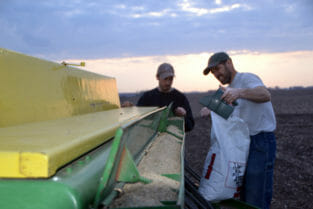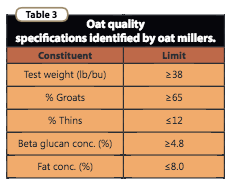Fungicides & Oats: apply or not?

Earl and son Matthew fill their drill to plant oats on their farm near Dunkerton, IA this past spring.
Practical Farmers of Iowa launched an Oat Pilot Project this year with seven farmer members who want to improve their ability to meet food grade oat market standards in the region by working together and sharing experiences. Earl and son Matthew Canfield farm near Dunkerton and planted 50 acres of various oat varieties this spring. Comments Earl, “[we] didn’t apply a fungicide last year and got along fine.” They are trying to learn how to grow heavy oats without pesticides. The biggest reason why oat farmers take a reduced payment when selling food grade oats is because the oats don’t meet the test weight requirements of food mills–they aren’t heavy enough. As shown in last year’s oat variety trial results  we can see that millers are looking for a very high quality product because their customers will be humans and most likely toddlers.
we can see that millers are looking for a very high quality product because their customers will be humans and most likely toddlers.
To bring up the test weight of oats grown in Iowa, farmers sometimes see a positive yield response from a fungicide application. But what are the best ways to make sure we are judiciously using fungicides? When is the most effective time during the oat plant’s growth to spray?
In the Oat Pilot Project we are fortunate to work with some of the best oat experts in the upper Midwest. Bruce Roskens from Grain Millers wrote in a recent article:
“From my experience, fungicides on OATS are most effective and should be applied at the first indication of pustules showing on the middle leaves anytime from 2-leaf to heading, and depending upon infection timing, virulence and weather, perhaps more than one application. If pustules appear on the flag leaf, application should be immediate, and some damage may already be occurring. The combo fungicides, such as Stratego, have had better effectiveness than single ingredient products, such as Tilt. The time of effective control seems longer than single ingredient materials. In the Midwest US states, we have seen some leaf damage – including setback of maturity – with products such as Headline, especially in periods of heat and/or drought stress. Is the material “too hot”, is it environmental stress on the plant, or is it likely a combination of all factors?
Too many farmers either think that fungicides have a preventative effect, and spray too early or “prophylactically”, and/or they wait too long after the fungus is already staging toward black spore or telia stage, and/or after heading. Timely scouting of fields is critical. Our results show minimal beneficial results of spraying the crop after heading. Damage to kernel fill has already been impeded, and maturity is likely to be delayed further. I believe farmers are more accustomed to spraying fungicides on wheat or barley AFTER heading to control fusarium, and think that timing should be the same on oats. Not true. Also – later growth stage spraying (private study done in southern Canada) showed that although yields and test weights were positively impacted, beta glucan levels dropped significantly (below 4% minimum required for heart health claim) in some genetics.
I personally believe that fungicide applications to oats can be quite beneficial for both yield and test weight enhancement, but it can/may delay maturity (can be good or bad, depending on regions and varietal maturity), and that far too many farmers are not applying at the most opportune time for benefit. I have heard of several farmers who have applied fungicides EVEN WHEN THEY DON’T NEED TO in response to stories of application enhancing yield potential, and too late have effect on any fungi. This can create higher risks for residues for milling quality oats. Also, for some of us millers who have food or feed applications for the hulls, we have potential residue concerns about ANY chemicals being applied after heading.”
Mac Ehrhardt co-owner of Albert Lea Seedhouse reminds us that,“using fungicides every year without scouting your crop is irresponsible and will likely lead to the development of fungicide-resistant diseases. We will then lose fungicides as an important disease management tool.” So to make sure you are making the right choice follow some of these steps for success.
Top 5 Steps to a Successful Oat Crop
- Timely scouting – looking for the appearance of reddish pustules on the leaves, both on top and under the leaf. This should begin by the 2 leaf stage, and occur at least weekly. Damp, humid conditions with heavy dews late into the morning are great promoters of the infections.
- Selection of a cost effective fungicide with more than one active ingredient is recommended if available
- Timely spraying BEFORE heading of the crop. Although there is evidence that fungicides can improve both test weights and yields of an oats crop, it must also be noted that they can delay maturity up to a few days.
- Some fungicides are approved for applications with broadleaf herbicides, but again – timing is important. We recommend early application of herbicides (before 4th leaf stage) for both effective weed control and less risk of injury to the crop. The most effective fungicide application MAY be after herbicide application.
- Avoid any and all residues on the harvested oats.
To read more about research results from fungicide trials see these reports: 2011 Crown Rust in Oats (1) and Foliar Fungicide in Oat Production.
